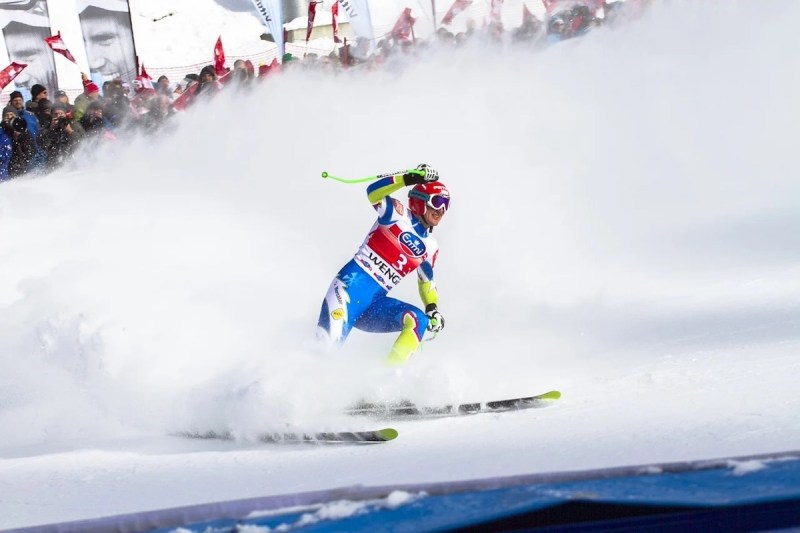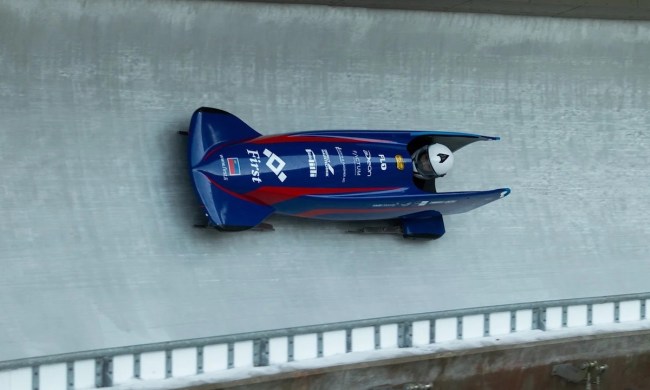Many of the Winter Olympic sports are somewhat hard to relate to. How many of us have actually pushed a bobsled and jumped in, racing down an icy track, or tried curling, luge, or biathlon for that matter? While these events are still engaging to watch, there’s something to be said about watching a sport you’ve tried yourself or can at least imagine more easily. The various skiing events at the Winter Olympics are crowd pleasers for this very reason. Whether you are still a season pass holder at your favorite ski mountain or never made it back on downhill skis since your early days on the bunny slope, more of us have probably hit the slopes on a pair of skis than a ice track on a luge sled.
That said, the skiing events at the Winter Olympics are still foreign to plenty of people, and there are quite a few Olympic skiing events to keep track of. However, we’ve compiled a guide to the skiing events at the Winter Olympics, including the sports of alpine skiing, ski jumping, and freestyle skiing, to help you prepare for watching the Winter Olympics. Also, be sure to check out our guide to cross-country skiing events at the Winter Olympics.
What Are the Skiing Sports At the Winter Olympics?

There are three primary skiing sports that use downhill skis at the Winter Olympics: Alpine Skiing, Freestyle Skiing, and Ski Jumping. Each of these sports has several disciplines and events.
What Are the Alpine Skiing Events at the Winter Olympics?

Alpine skiing refers to traditional downhill skiing. There are 11 alpine skiing events at the Winter Olympics:
- Men’s and Women’s Downhill
- Men’s and Women’s Super-G
- Men’s and Women’s Slalom
- Men’s and Women’s Giant
- Men’s and Women’s Combined
- Mixed Team Event
Downhill
The Downhill event features a long, relatively straight straight, with few turns, and is considered a speed event. Of the alpine skiing events, the speeds athletes reach in Downhill are usually the fastest. Athletes get one run to race down the course one at a time. The fastest time wins.
Super-G
Like Downhill, Super-G is a speed event, but there are gates that athletes must navigate through, so it is more technical in nature. It debuted at the 1988 Winter Olympics. In the Super-G skiing event, competitors race individually, get one run, and the fastest time wins. Missing a gate results in disqualification unless the competitor hikes back uphill and successfully passes through the missed gate.
Slalom
Slalom is a technical event rather than a speed event, though speed matters. The slalom course is the shortest of all the alpine skiing courses and has numerous very quick turns around gates that athletes must navigate. Each competitor gets two runs down the course and the sum of their two runs serves as their total time. The fastest total time wins. Again, missing gates results in disqualification unless the athlete walks back uphill to go through the gate.
Giant Slalom
The race format and concept of the Giant Slalom is the same as Slalom but the course is longer and has fewer and wider turns. As such, while Giant Slalom is still a technical event, the speeds are much faster.
Super Combined Event
The Super Combined Event includes two runs over one single day. The first run is Downhill and the second run in the later part of the day is Slalom. The total time for both runs is used to determine the final rankings.
Team Event
The Team Event involves a bracket-style competition of 16 teams going head-to-head in Slalom events. Each team has four athletes (two men and two women).
What Are the Freestyle Skiing Events at the Winter Olympics?

Freestyle skiing at the Olympics is growing, with two new events debuting at the 2022 Winter Olympics in Beijing: Big Air and Mixed Team Aerials. Slopestyle and Freestyle are also relatively new, making their first appearance at the 2014 Winter Olympics in Sochi.
There are 13 freestyle skiing events at the Winter Olympics, including the following:
- Men’s and Women’s Moguls
- Men’s, Women’s, and Mixed Team Aerials
- Men’s and Women’s Halfpipe
- Men’s and Women’s Ski Cross
- Men’s and Women’s Big Air
- Men’s and Women’s Slopestyle
Moguls
The moguls event was first included at the 1992 Winter Olympics in Albertville. Competitors race down a ski slope covered in moguls, which are large, rounded bumps of snow. They must also perform tricks off two jumps along the course. Judges evaluate the tricks and technical performance navigating the moguls. While speed factors into the final score, this is not a race; rather, it is a judged event based on the ability to execute tricks skillfully and with precision.
Aerials
Aerials debuted at the 1994 Winter Olympics in Lillehammer. Skiers launch themselves off large jumps and perform elaborate flips and twists.
Ski Cross
In Ski Cross, four skiers race down a motocross-inspired course featuring obstacles such as jumps banked turns, and rollers. The top two finishers per round advance to the next round.
Slopestyle
Most Slopestyle downhill courses feature six obstacles — three jumps and three rails — and skiers execute tricks off the obstacles with the goal of earning the most points.
Halfpipe
Halfpipe, also called superpipe, is a freestyle skiing event where athletes traverse through the halfpipe — a U-shaped track with 22-foot walls — while performing tricks off the walls. A panel of judges score each skier based on the difficulty, variety, and execution of the tricks they attempt, their use of the halfpipe, the height they achieve, and their ability to link tricks together in a progressive way.
Big Air
Big Air will debut at the 2022 Winter Olympics in Beijing. It consists of a single big jump. Skiers have one chance to execute their most impressive tricks as they hit the jump. Jumps are scored based on difficulty, execution, amplitude, and landing.
What Are the Ski Jumping Events At the Winter Olympics?
Ski jumping may seem like it would be a newer sport, but it actually has been a contested event for men since the inaugural Winter Olympics in 1924. On the other hand, women’s ski jumping debuted at the Winter Olympics in 2014. There are five ski jumping events at the Winter Olympics:
- Men’s Individual Normal Hill
- Men’s Individual Large Hill
- Women’s Individual Normal Hill
- Men’s Team Large Hill
- Mixed Team Normal Hill
The Men’s Individual Normal and Large Hill events both consist of two training sessions and a qualification round before the final, where the qualifiers contend for the medals. Each nation (National Olympic Committee) can enter up to four athletes for each event and 50 athletes qualify for the final. The qualification round consists of one trial jump and one scored jump, while the final has one trial jump and two scored jumps. The final rankings are determined by the scores of the two jumps in the final, with the highest score winning.

On the other hand, the women’s individual event only includes a final; there is no elimination round. All 30 entrants are eligible to compete for the medals. The final includes one trial jump and two scored jumps, with the winner determined by the highest summed score for their two ski jumps.
The men’s team ski jumping event takes place on the large hill and involves teams of four athletes. After a trial round, there are two competition rounds. Each jumper on the team ultimately takes two scored jumps and the team with the highest total score wins.
The mixed team event features teams of four athletes — two men and two women — per nation, but only those nations that have qualified two men and two women for the individual events may compete. The scores are calculated by summing each jumper’s two scored jumps in the final.
Competitors in ski jumping events are scored based on the distance they jump, the style points they earn, and the gate and wind compensation points for their jump. The jump distance, which is recorded by video camera, is calculated from the take-off point to the exact point on the slope where the jumper’s feet touch down. A panel of five judges also rate each jump and assign style points based on the power, boldness, precision, fluidity, and control of the jump. Each judge scores the jump from 0-20, but the highest and lowest scores are dropped. Therefore, a ski jumper can earn a maximum of 60 style points.
Finally, points can be added or subtracted to a jumper’s score based on the wind and gate. A tailwind results in points subtracted while points are added to adjust for a jump in a headwind. Points are deducted for a higher starting gate and added for a lower one.





